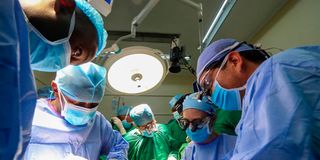What it will take to make our hospitals safer for patients

Doctors carry out surgery on a patient at Kenyatta National Hospital on April 25, 2023. Ensuring safe surgery is important because the patients are often operated under anaesthesia, a situation in which they are not able to confirm or point out any errors.
What you need to know:
- Every hospital must have wrist bands on their patients. The bands should contain the patient’s full name and another unique identifier such as a hospital number.
- Patients should not be referred by one name or bed location or their disease (such as the old man in bed seven with pneumonia).
The World Health Day was celebrated on April 7 with the theme ‘My Health, My Right’. It is ironic that this is happening smack in the middle of industrial unrest in our healthcare system, a situation that has made services in our hospitals unsafe. Safety is one of the six domains of healthcare quality; the others being effectiveness, patient centredness, timeliness, efficiency and equity.
Before healthcare quality became a priority area, seminal work by the American Institute of Medicine titled ‘To Err is Human’ established that more deaths occurred from medical errors than road traffic accidents, malaria or HIV/Aids.
Since then, different health quality and standards organisations have always put patient safety at the foundation of any quality accreditation or standardisation.
One such body — The Joint Commission International (JCI) - has outlined the six areas of concern for patient safety. These are dubbed the International Patient Safety Goals.
It is incumbent on all hospital managers and the regulatory bodies to put in place mechanisms to ensure these baseline standards are adhered to and monitored.
The first patient safety goal is to identify patients correctly
Every hospital must have wrist bands on their patients. The bands should contain the patient full name and another unique identifier such as a hospital number. Patients should not be referred by one name or bed location or their disease (such as the old man in bed seven with pneumonia). Using one name has led to serious medication errors as many patients in the same ward can share one name.
Effective communication
It is important that closed loop communication is used when handling sensitive patient information.
It is recommended that when communicating a delicate matter (such as lab results), hospital staff should introduce themselves, give clear communication on the matter at hand and the person on the other hand should be able to document this information completely. This second person should then read back the relayed information to the person who gave it to ensure that it has been captured as accurately as was intended.
Improve management of high alert medications
There are different categories of medicines within a hospital that are dubbed high alert such as concentrated electrolytes like potassium chloride and look-alike sound-alike medications. These are supposed to be controlled in a way that more than one person is involved in their retrieval to be given to the patient.
This check will ensure that the likely error from one staff is corrected by the second. It is recommended that these are prescribed in full in words and the dosage is given in words as opposed to figures.
Safe surgery
Ensuring safe surgery is important because the patients are often operated under anaesthesia, a situation in which they are not able to confirm or point out any errors. It is expected that the patient must sign a full informed consent and site of surgery must be marked. Just before surgery, the team must have a moment to introduce themselves, confirm the identity of the patient and procedure being done and ensure all equipment and tools are working. The WHO Surgical Safety Checklist is a valuable tool to use.
The introduction of this checklist has reduced deaths arising from surgical complications by up to 62 per cent in some units.
Reduce risk of hospital acquired infections
Such include infections at the surgical sites following operation, urinary infections in the wards following catheterisation or pneumonia in the ward after a patient has been connected to a breathing circuit. Hospital acquired infections increase hospital stay and thus the total hospital bill.
Reduce the risk of patient harm resulting from falls
It is estimated that up to one million falls happen per year among hospitalised patients. To reduce the risk of falls, it is important to identify patients who are at high risk of fall. These include patients immediately after surgery as they are still under anaesthetic medications, confused patients, patients with broken limbs or those who have had surgery on the legs, elderly patients to name but a few. It is best to tag such patients with a specified wrist band that is known to the entire hospital staff so that it is easy to spot and support these patients.
It is time regulatory authorities and insurance panels looked at our hospitals through the lens of patient safety initiatives and quality improvement programmes as a requirement for their empanelment.
Dr Aruyaru is a consultant general surgeon




